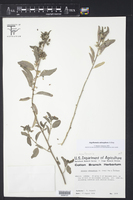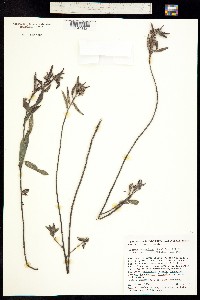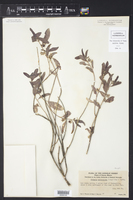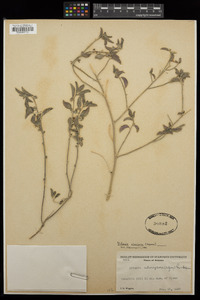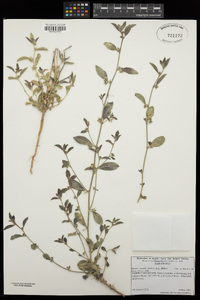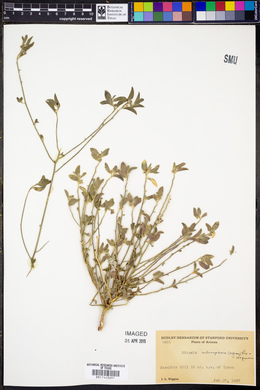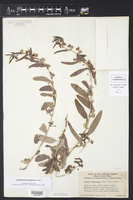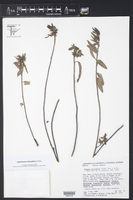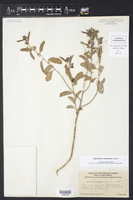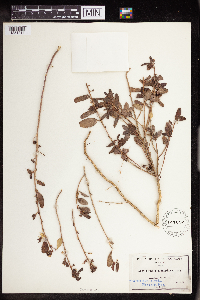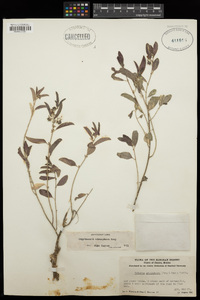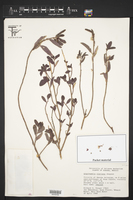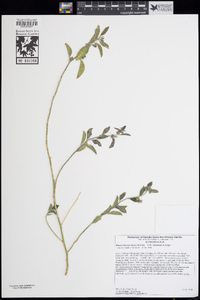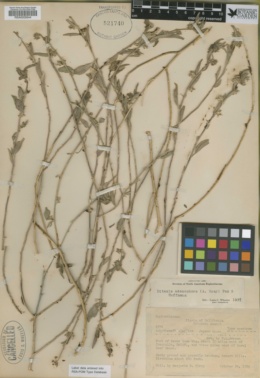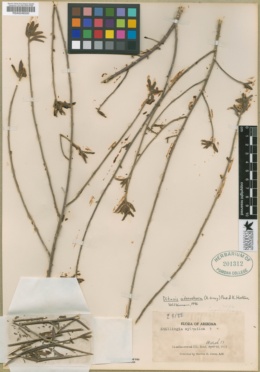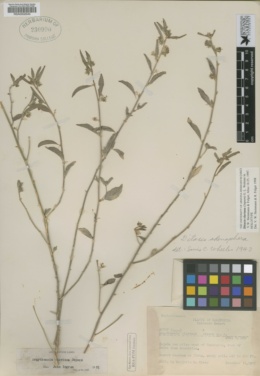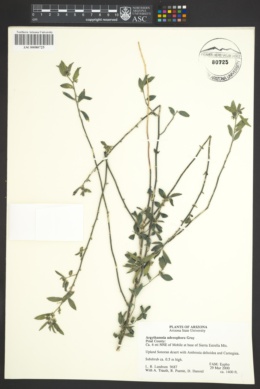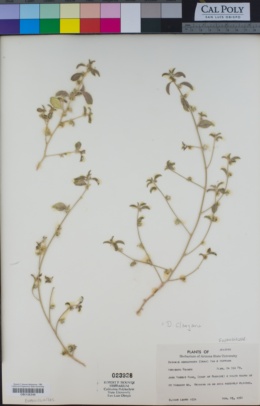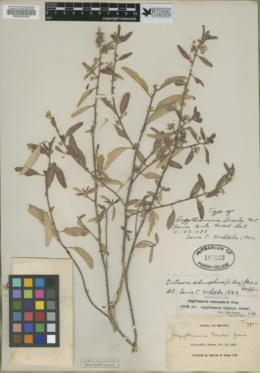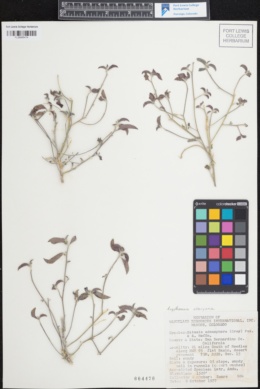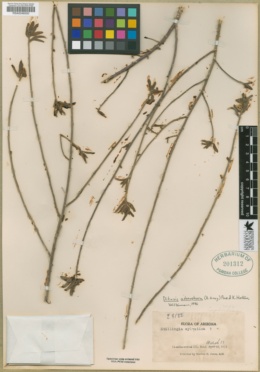Ditaxis claryana
|
Ditaxis claryana (Jepson) G.L. Webster
 (redirected from: Ditaxis adenophora auct. non (A. Gray) Pax & K. Hoffman) (redirected from: Ditaxis adenophora auct. non (A. Gray) Pax & K. Hoffman) |
|
|
Family: Euphorbiaceae
Desert Silverbush, more...desert silverbush, Sonoran Silverbush, glandular silverbush
[Argythamnia adenophora auct. non A. Gray, moreArgythamnia claryana Jepson, Ditaxis adenophora auct. non (A. Gray) Pax & K. Hoffman, Ditaxis clariana (Jeps.) G.L. Webster] |
Jepson 2012, Kearney and Peebles 1969 Duration: Perennial Nativity: Native Lifeform: Forb/Herb General: Herbaceous or subshrubby annuals, to 50 cm tall, stems spreading to erect, lightly striated, herbage with some hairs simple and spreading, others 2-forked and appressed, plants with clear sap. Leaves: Alternate, lanceolate, 1-4 cm long, margins finely gland-toothed, blades hairy beneath, petiolate with gland-toothed stipules 1.5-3 mm long. Flowers: Inconspicuous and greenish-white, usually almost enclosed by leafy subtending bracts with gland-tipped teeth, flowers staminate and pistillate; staminate flowers with glabrous to hairy petals 3.5-5 mm long, sepals hairy, 3.5-5 mm long, stamen columns 1.5-2 mm long, pistillate flowers with petals 3.5-5 mm long, unequal sepals 3.5-5.5 mm long, with glabrous or hairy surfaces and gland-tipped teeth, ovaries sparsely hairy, styles fused proximally with expanded lobe tips, infloresences subtended by bracts with entire margins, infloresences borne in leaf axils and at stem tips, the staminate flowers generally distal to the pistillate flowers (staminate above, pistilate below), infloresence axis with appressed to spreading hairs. Fruits: Smooth capsules to 4.5 mm long. Seeds angled, faintly pitted, to 2 mm long. Ecology: Found on sandy soils, in creosote-bush scrub, to 350 ft (106 m); flowering December-March. Distribution: Arizona, California. Notes: This plant has sparsely felty, generally appressed long hairs on its leaves and stems, the leaf margins are minutely toothed, the tips of the teeth almost but not quite spiny, the underside of the leaves have conspicuous raised veins, the inconspicuous flowers are generally found amongst the leaves at the stem tips and in leaf axils along the stem. Jepson has this species under the name of Ditaxis claryana as of May 2012. Kearney and Peebles have the keys to this species as the gland-tipped teeth present on the leaves, bracts, and pistillate sepals. Ethnobotany: Unknown. Synonyms: Argythamnia adenophora, Argythamnia bicolor Editor: LCrumbacher2012 Etymology: Ditaxis comes from the Greek dis, "two," and taxis, "rank," referring to the stamens which are in two whorls, and adenophora means bearing or producing glands as some part of the plant, often referring to sticky glands. Jepson 2012 Duration: Perennial Nativity: Native Lifeform: Forb/Herb General: Annual or perennial herbs, to 50 cm tall, stems spreading to erect, lightly striated, herbage with some hairs simple and spreading, others 2-forked and appressed, plants with clear sap. Leaves: Alternate, lanceolate, 1-4 cm long, margins finely gland-toothed, blades hairy beneath, petiolate with gland-toothed stipules 1.5-3 mm long. Flowers: Inconspicuous and greenish-white, usually almost enclosed by leafy subtending bracts, flowers staminate and pistillate; staminate flowers with glabrous to hairy petals 3.5-5 mm long, sepals hairy, 3.5-5 mm long, stamen columns 1.5-2 mm long, pistillate flowers with petals 3.5-5 mm long, unequal sepals 3.5-5.5 mm long, with glabrous or hairy surfaces and stalked-glandular hairs on the margins, ovary sparsely hairy, styles fused proximally with expanded lobe tips, infloresences subtended by bracts with entire margins, infloresences borne in leaf axils and at stem tips, the staminate flowers generally distal to the pistillate flowers (staminate above, pistilate below), infloresence axis with appressed to spreading hairs. Fruits: Smooth capsules to 4.5 mm long. Seeds angled, faintly pitted, to 2 mm long. Ecology: Found on sandy soils, in creosote-bush scrub, to 350 ft (106 m); flowering December-March. Distribution: Arizona, California. Notes: This plant has sparsely felty, generally appressed long hairs on its leaves and stems, the leaf margins are minutely toothed, the tips of the teeth gland-tipped (use a hand lens); the underside of the leaves have conspicuous raised veins; the inconspicuous flowers are generally found amongst the leaves at the stem tips and in leaf axils along the stem. In particular, focus on the tiny gland-tipped teeth on the leaves and bracts; this trait separates this species from others in the genus. Look for this species under D. adenophora in older literature. Ethnobotany: Unknown. Synonyms: Ditaxis adenophora, Argythamnia adenophora, Argythamnia claryana Editor: LCrumbacher2012 Etymology: Ditaxis comes from the Greek dis, "two," and taxis, "rank," referring to the stamens which are in two whorls; the meaning of claryana in unknown. |
|
|
|















